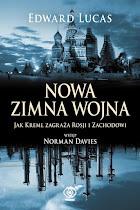Europe.view
Horror films
From Economist.com
Why eastern Europe needs Hollywood
“KATYN”, the new film by Andrzej Wajda, Poland’s best-known director, should leave you shaken and sleepless. It is worth seeing just for the scene in which the senate of Cracow University is arrested en masse by the Nazi occupiers, as well as for as the almost unbearably realistic execution scenes in which Soviet murder squads kill 22,000 captured officers, and also for the way it portrays the attempts by the communist lie machine in post-war Poland to cover up the truth.
Yet for all its passion and authenticity, the film is disappointingly muddled, and too narrowly focussed on a Polish audience. Popular culture demands a strong and simple story line to make reality convincing to the jaded sensibilities of a modern international audience. Mr Wajda fails that test: he uses too many characters, and too much detail distracts the viewer from the central message. What is really needed is a film with the broad sweep of “Schindler’s List” that will explain the full horror of Soviet dictatorship both during and after the war.
The lack of archival footage is a problem. It is all to easy to see films showing the Nazi concentration camps, while even still pictures of the Gulag are scarce and grainy. That need not be a snag for those with the budgets to stage re-enactments. This is what Mr Wajda has done with “Katyn”. Now a plethora of other stories cry out for the same treatment.
First should be the Kengir uprising of 1954. After Stalin’s death, a huge prison camp in Soviet Kazakhstan revolted and maintained an astonishing six weeks of freedom from May 16th to June 25th. The camp’s inmates—mainly Ukrainians, with a sprinkling of Balts and Russians—outfaced and out-organised the bureaucrats and goons who ran the camp, until in the end they fell victim to a full-scale military assault. Almost unknown in the West until Aleksander Solzhenitsyn’s account in the “Gulag Archipelago” the Kengir rebels deserve to be remembered and honoured for their Masada-like courage, ingenuity and solidarity.
| |
 | |
Andrzej Wajda, director of “Katyn” |
Second should be the deportations to Siberia from the Baltic states and elsewhere in eastern Europe. “Collect your things!” barks the arresting NKVD officer in the Wajda film to a woman and child whose only “crime” is to be the family of a Polish officer—who by then is already dead in a ditch in a forest near Smolensk. Such hurried packing in the middle of the night, followed by a cattle-truck to Siberia, was the fate of tens of thousands of people across the Soviet-occupied territories of eastern Europe in a few June days in 1941. Those few that returned came home not as heroes but as released criminals, living on the fringes of Soviet society.
Third should be the “Forest brothers” of the Baltic states and western Ukraine, as well as the Polish “Home Army”. They maintained a doomed struggle against the Soviet occupiers in some cases until the late 1950s. The last Estonian partisan, August Sabbe, survived until 1978. Betrayed by traitors in Britain’s MI6 in the late 1940s, their story makes Rambo’s adventures in Indochina seem like Disney-style pap.
Perhaps most gripping of all is the story of Witold Pilecki, a Polish intelligence officer who volunteered to be imprisoned in Auschwitz in order to find out what was happening there. When he escaped and reported to the Allies what he had discovered, they said he was exaggerating. After the war, he was captured by the communist authorities and executed in 1948.
If the screenwriters get going, the West’s historical understanding will belatedly gain some balance. But do bring plenty of handkerchiefs.
























2 comments:
Edward. For someone who claims to be a veteran reporter with 20 years of experience in Eastern Europe, you've just showed an amazing lack of knowledge about, what you've called the "forest brothers",especially the Ukrainians. The ukraininan bandits from Organistation of Ukrainian Nationalists, UPA and various other para military groups have become known not for their fight against Germans, since for most of the war they were actually collaborrating and supporting the nazi regime, nor for their battles against Russians, as those were virtually non existant, but for the genocide of Poles, unarmed peasants, priests, teachers, old, women and children alike. Giving those bandits any credit, and putting them in the same cathegory as polish or baltic underground is bordering on an insult.
Hi Pawel
I certainly know that Polish experience with the UPA was extremely unpleasant. However the Ukrainian resistance to the Soviets is much more complicated than either you or I have described. But my point is that it would be a great subject for a film. Each country tends to remember its own partisan resistance more kindly than it does its neighbours--for example the Lithuanian partisans regarded the Armia Krajowa as just another occupying force and fought them hard in 1944, when of course in retrospect both sides should have been concentrating on something else!
regards
Edward
Post a Comment